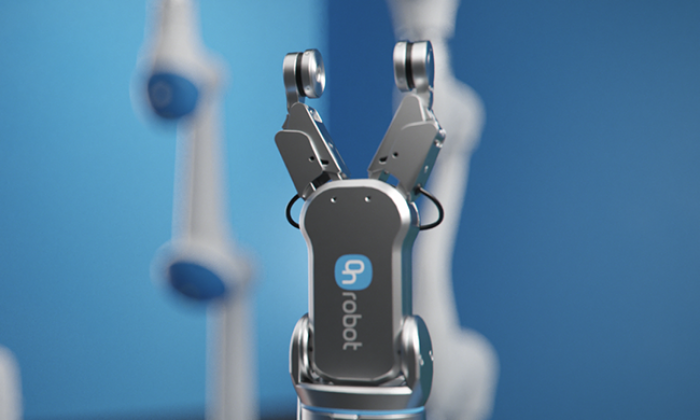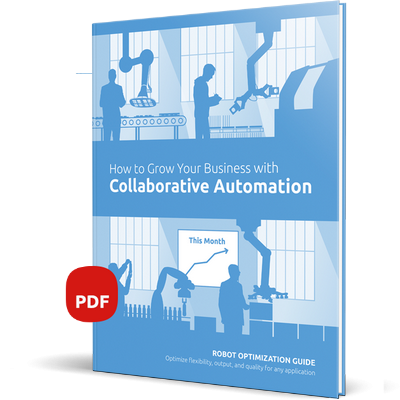Collaborative robot applications: Practical use of end effectors


The industrial world is once again going through a revolution made possible by small, affordable collaborative robots. Due to these lightweight and highly flexible collaborative robots - also known as cobots - the manufacturers can reap the benefits of collaborative automation and increase productivity at a lower cost.
Due to smarter, more adaptive robot arms and end effectors, automation is now set up at a fraction of the time it takes for traditional industrial robots. A wide range of tasks can now be accomplished thanks to the versatility and flexibility of the end effectors, maximizing return on investment.
What is a robotic end effector?
According to the Collins dictionary the term effector is used for a body part that becomes active in response to stimulation and “In robotics, an end effector is the device at the end of a robotic arm, designed to handle objects.”
The end effector (also known as end-of-arm tooling) sits at the end of the robot arm and moves only when a human operator activates it through the associated software.
A robotic end effector is the device that is mounted onto the end of a robot arm. The end effector is the part that reacts to stimuli and interacts with the environment. In other words, it is the end effector that picks and places objects, assembles product pieces, stacks cartons and parcels etc. A process cannot be automated and optimized without a robotic arm, but it is the end effector that enables the robot to perform its deeds.
Think of it as the robot arm being the equivalent of a human arm, with the robot end effector being the equivalent of a human hand. An arm can move, but it is no good without a hand. The same applies for robot arms and end effectors.
The choice of end effector depends on the task at hand - different end effectors are appropriate for different applications.
6 applications of end effectors
- Pick & Place
Pick & place tasks are those where an object needs to be picked up and placed in a different location. This sort of task requires precision and the ability to safely handle the object no matter the material it is made from or how fragile it is.
Which gripper type is the right for you depends on what you are trying to accomplish and what kind of objects need to be handled. Classic grippers have a large stroke and customizable fingertips, they can be used to sort materials according to shape, material and size. Grippers with the F/T sensors are used when the sensitivity of the human fingertips is needed reducing defect rate as much as 60% in delicate Pick & Place processes. Electric vacuum grippers are customizable and able to safely handle objects of various shapes and sizes, while the adhesive grippers enable gripping of flat, porous object with precise, no-mark technology.
- Machine Tending
Machine tending tasks are typically those of overseeing a machine as it performs its task and loading and unloading machines, but can also include part inspection, blow off, wash, sorting and packaging.
It is very common (especially in the metalworking industry) that the human workers feed various parts into the machine for processing. This manual process is dull and as it requires a high level of consistency over a long period of time, the risk of injury or product inconsistency is high. Using a cobot increases safety and product quality and decreases cycle times, while freeing the worker for higher level tasks. Also, as the cobot can be used 24/7, you can now take on bigger jobs
- Packaging & Palletizing
Packaging and palletizing processes include precise, high-speed packaging assembly, product loading and pallet forming among others. This is a very demanding part of production as it requires the goods to be handled fast, but with the utmost of care (especially those items that are fragile).
Automating packaging and palletizing can make the whole process simpler, faster and easier. The human workers are spared lifting heavy objects or working in unergonomic positions that cause injuries.
A collaborative packaging robot with a flexible end-of-arm tool attached can optimize packaging processes and relieve your workers of repetitive tasks. When packing your products for shipping, it is very important that they are counted correctly and palletized according to safety standards.
The flexibility and high speed of redeployment make cobots ideal for any sort of production as they are lightweight, easily moved and can be used sequentially in different points of the production process.
Watch how Plus Pack automated packaging >>
- Assembly
When we talk about assembly tasks, we mean the manufacturing process where the product is being built by adding parts one at a time in a precisely determined order.
This often requires the cobot to handle objects of various size and shape. Sophisticated sensors and easy programming of tasks allow for the automatization of product assembly where objects of different material need to be manipulated. As an example, the cobot can interchangeably handle wooden, plastic or metal parts and adjust accordingly to consistently produce high quality products with next to zero defect.
- Quality Testing & Inspection
When certain products are tested a consistent force needs to be applied on product after product. This sort of precision that requires the same tension and pressure is difficult to demand from the human workers but can be an easily programmable task for the cobot. Same goes for tedious product tests that require many sequential steps like for instance pushing each and every button on a product.
Sophisticated torque/force sensors and flexible grippers make it possible to automatize product testing and ensure the high level of quality while handling the product with the utmost of care.
- Surface Finishing
Surface finishing is a process that requires flexibility. It is one of the dirtier tasks in the production line which makes it perfect for automation.
The surface finishing processes that a cobot can do effectively are sanding, polishing and buffing which can be performed on various material ranging from plastic, metal and wood to even marble and carbon fiber. Every surface is different, but no matter how small the variations a cobot can be programmed to achieve an even surface finish.
Sometimes a particular polishing pattern needs to be used. These are easily programmed with the hand guiding functionality making deployment faster than ever.

|
협업 애플리케이션으로 비즈니스 성장을 이끄는 방법
보다 지능적이고 적응성이 뛰어난 툴링이 시작되면서, 로봇은 이제 광범위한 작업을 수행하면서 ROI를 극대화 시키는 더 빠른 속도, 강도, 안전 및 정밀도와 함께 작동합니다. 무료 eBook을 다운로드하여 저렴한 비용으로 더 빠른 생산을 가능하게 하는 방법에 대해 자세히 알아보십시오.
무료 eBook 받기
|

|

